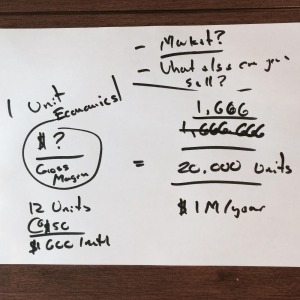
A few months ago I had lunch with my cousin who runs a property management company. He started telling me that he was having a hard time growing his business. So I asked him a few questions. I realized his challenge wasn’t in sales, it was that he didn’t understand his market or the “unit economics” of a customer. In the technology world – my world – we consider this the holy grail of measurement: How much revenue do you make from a new customer and what did it cost to get that customer?
So I walked him through a simple exercise that I’ve done with hundreds of entrepreneurs. Here’s how it works… first question:
1. What does a traditional customer looks like?
This is the ideal or average customer. If you sell multiple things, pick one and define it for that sale. For my cousin, that was an owner of a 6 unit apartment building. That’s his ideal customer.
He continued to explain that, all averaged in, he charges $50/month per unit to manage it. So 6 units x $50 = $300/month. Sure there are other setup fees, advertising costs, etc. – but I like to keep it simple, so we went with that number.
2. What does it cost you in time & money to service that customer?
I never include the cost of sales or marketing in this number, as it only confuses things … only the time & money to deliver what you promised, to that customer, for that service.
So for my cousin, that was:
- Time each month to pull the reports (30 mins)
- Calls from the tenants (1 hour)
- Managing any maintenance work (1 hour)
Total: 2.5 hours
Decent enough for $300.
Anything like advertising a new unit, hiring contractors to fix damages, etc, were always above his fees – so those things weren’t important for this exercise.
3. How many customers are there in your city that fit this description?
This is a market size question. How big is the market of potential customers?
This question stumped him. He had never thought about this question. So I started asking him a few other clarifying questions:
- Are there any public lists or data on apartment buildings?
- What other types of businesses sell stuff to building owners?
- Do these building owners register with the city?
It took a few minutes online to find some data, but it was available. For him it came from a mortgage broker, real estate system and city hall.
For you, it may take more time… but it usually turns out that someone has it. Even if it’s some kind of ratio, like 15% of all building in your city are multi-units, or there’s over 50,000 apartment units in the city. That’s a good start. Just get something to “guesstimate” with.
This is more about the process, then the accuracy.
4. How many would you need to do $1M in gross revenue?
This one is a simple math exercise.
If he knows he’s getting $50 per unit, then divide 50 into 1M = 20,000 units. If 12 unit buildings are his ideal customer, then that would be 1,666 buildings.
“WOW, that’s a lot of buildings” he said.
He had never thought about it like this. Most entrepreneurs don’t.
For example, a restaurant could use the average table turnover rate required in a year to do a $1M dollars. That information is available online. Understanding this is crucial.
5. What’s the effort involved in getting a new customer?
“A lot” he said. “I’m currently getting 1-2 new buildings a month, so 1600+ would take me over 100 years. WTF?!”
This question is another way of asking, “How much does a new customer cost to acquire?” In the tech world, we call this CAC (Cost to Acquire a Customer).
This is where most business owners start to realize that they need to change something… either they go “upmarket” (more income per customer), charge more (raise their prices), or get more efficient at scaling their business (increase the velocity of their sales & decrease payback periods).
For my cousin – I thought – it was a simple decision.
1) Go upmarket to manage bigger buildings and be known as the best in the city for that type of building. Or…
2) Start buying/building his own buildings to manage himself to add to the top line.
Unfortunately, to this day (9 months later) he still hasn’t made a decision.
Please don’t be my cousin.
Take a few minutes to answer the questions above and ask yourself, is this worth it?
What would you need to change to increase the unit economics of your business so you could grow faster to achieve your goals?
Here’s a quote that might help put things into perspective:
Ask not if you are worthy of your goals, ask instead – are your goals worthy of your life?
Boom! Powerful, eh?
That one sentence has helped remind me to review the “unit economics” (ha, just realized the pun) in every business that I’ve started since. It’s now part of my default state in business and I hope you find it useful.
—
So, do you have a “cousin” that isn’t willing to look at their business through an honest lens? If so, I would love to hear their story in the comments below.




Comments (0)
Leave a comment